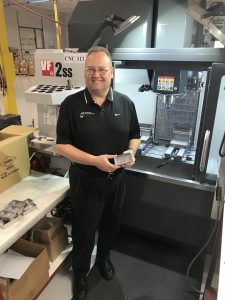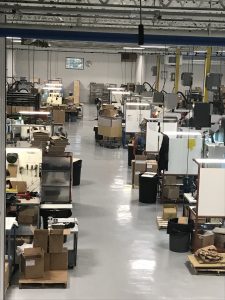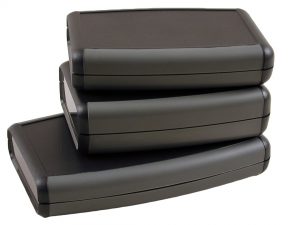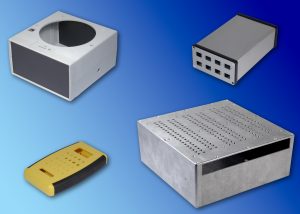
Hammond Manufacturing puts custom touch on enclosure designs
Stephen Law
Electronics custom custon enclosures enclosures Hammond HammondNew Waterloo facility focuses on delivering modification services for multiple application uses

Ross Hammond, business development manager, stands next to one of the Waterloo-based firm’s CNC machines, used to modify enclosures to the customer’s liking.
Representing its fifth production facility within the Greater-Waterloo area, Hammond Manufacturing recently opened a 26,000 square-foot enclosure modification plant – focused on serving customer’s needs in a variety of application use sectors.
Marking its 100th anniversary year in 2017, Hammond operates facilities in Canada, USA, UK, Australia and Taiwan, however the vast majority of products are manufactured in Ontario.
EP&T Magazine took the opportunity to speak with Ross Hammond, business development manager of Hammond Manufacturing about the new modification centre.
——————-
Q. How does this facility (on Colby St Waterloo) differ from the 117,000-square-foot facility Hammond opened in Guelph two years ago?
Our newest Guelph facility is focused on metal fabrication, mainly for our data communications cabinets. Our new Waterloo facility houses our 13 CNC machining centers, along with printing and assembly.
Q. Will the two facilities operate in conjunction with each other on customer orders?
The Guelph facility houses our state-of-the-art powder painting line, and is a key part of our modified enclosure production process. Many of our die cast aluminum enclosures will be painted in either stock or special colours.

Hammond’s 26,000 square-foot enclosure modification plant in Waterloo ON.
Q. What is driving the growth in need for modification of enclosures? Are there any specific application sectors leading this need?
Our customer base is very diversified and we are seeing growth across almost every sector. We are seeing notable growth in industrial control and sensing applications, driving by products related to IOT. Watertight products are also doing quite well, as the requirements to meet high IP levels dictates that the enclosures should be professionally machined. We also promote the concept of one-stop-shopping, where the machining, painting, and printing can be offered thereby reducing the need for an end user to subcontract these services.
Q. Describe the variances in customization or modification requests from Hammond’s customer base.
We’ve really seen it all, from crude sketches on paper all the way to complete 3D software files. Our design team then takes over and helps bring the customer’s dream to reality.
Q. What new capabilities has Hammond added with the expansion of this new facility?
Our increased square footage gives us more flexibility for light assembly. We have added in-house digital printing which greatly increases the printing options available to our customers, particularly for smaller quantity orders where silk-screening may have been cost prohibitive.

Hand-held watertight enclosures from Hammond.
And of course a main reason for the expansion was our addition of 5 new CNC machines in the last year, bringing our total in Waterloo to 15. (We also have 6 CNC machines in our UK facility which focus on our European customers.)
Q. What is turn-around time for custom product orders? What variables impact that time-line?
The front-end process for modified enclosures can take approximately one week, as we work with the customer on approval drawings and the first-article sample. This is an important check not only for ourselves to ensure that we are modifying to the exact requirements, but also for the customer to double-check the fit of their components. Production time itself will vary from two weeks to four weeks, based on quantity but also on additional processes required. PEM inserting, painting, and printing are some of the additional steps that may be required. Enclosure inventory is rarely an issue, as we mould most of our own products, or maintain a large inventory of our products that are produced in our other worldwide facilities.
Q. Describe the breadth of order sizes this new facility will accommodate (prototyping to small production runs)?
We see orders from 5 pieces all the way up to 10,000 pieces or more. At the higher quantities a customer may benefit from custom moulding options, but we do find that some customers are quite happy to maintain flexibility in their design and continue to use a machined enclosure.

An assortment of ABS plastic instrument enclosures.
Q. What type of technical or engineering support is available to newbie customers reaching out for help in the design process?
Our design time is always happy to spend time working with the customer to fine-tune their modification requirements. Our design and sales team members have worked with thousands of designs and are also familiar with many components, and as a result we can often help a new customer with their hardware and component choices.
Q. Describe the complications of being an enclosure provider, often regarded as the final step in the design process of any electronic device. (meeting customer expectations, time-lines, etc.)
We often say, with tongue-in-cheek, that customers should choose their enclosure first. It can be challenging to help a customer who has a specific circuit board size that won’t fit into an existing enclosure size. Some enclosure styles such as extruded aluminum have some flexibility as we can vary the length to suit customer needs. Our honest suggestion is for customers to involve us early enough in the design stage so that we can ensure an off-the-shelf enclosure to fit their needs.
